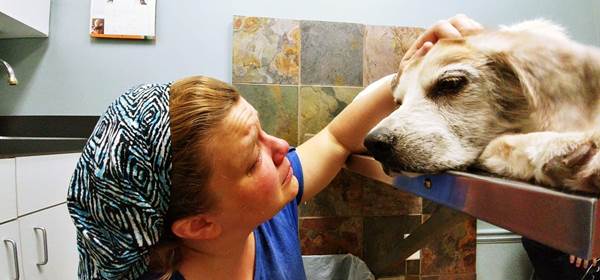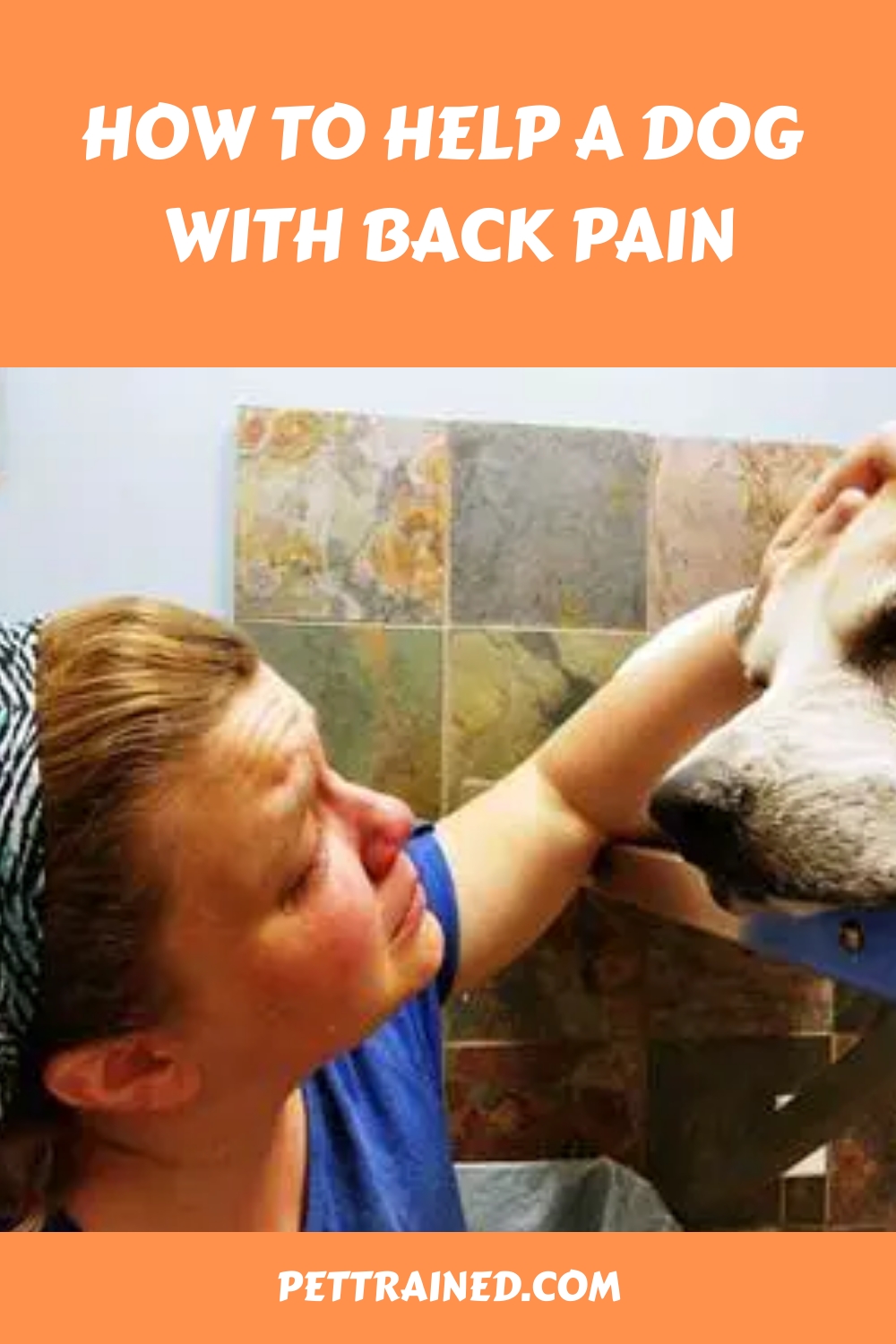
How To Take Care Of A Dog With Back Pain
You may not know this but among all pets, dogs experience back pain the most. No one likes having pain even dogs, so it is necessary to know how to help a dog with back pain if you have a dog of your own.
There are many ways you can help your dog experiencing pain involving a variety of treatments. These treatments may be a light quick remedy or heavy long detailed regimen depending on the cause of the pain and the breed of the dog. We will get to all of that but first, let’s know what this dog back pain really is.
What is dog back pain?
Dog back pain is an unpleasant bodily sensation on your dog’s back that causes discomfort. Many dogs experience this and it can be triggered by different things.

What causes back pain in dogs?
There could be several reasons. It could be because of an injury, a disease or infection, aging and other reasons which would be discussed in this article.
You will need to be the one to notice when your dog is in pain because it can’t tell you on its own. Additionally, in this scenario, there are symptoms you can look out for which can help you know if your pet is experiencing pain or not.
The symptoms vary depending on the cause and how severe the condition is but a reluctance to movement and posture change are the most common.
Since there are many possible causes of your dogs’ back pain, identifying the particular cause might be difficult and thus requires the involvement of a professional – a veterinarian.
These are skilled personnel on animals’ health and they can help identify the cause by carrying out specific tests and examinations.
Here are some more common mistakes that cause back pain in dogs.
Also See:
Symptoms of Back Pain in dogs
To help you identify if your pet has back pain or not, let us look at some of the symptoms associated with it;
- Difficulty in walking: when your dog finds it difficult to walk around, it could be as a result of it having back pain. Sometimes, it may refuse to walk at all.
- Abnormal gaiting; if your dog changes movement pattern and finds it difficult to walk the usual way, back pain can be the cause.
- Constant whining/crying: Having back pain makes a dog uncomfortable and if it is too painful, they may cry and whine often especially when touched.
- Posture change: Back pain can bring about changes in your pets’ posture. It may find it difficult to stand or sit properly.

Recognizing these signs on time is important so you can help your pet. Knowing the cause of the back pain is important too as it will enable you to know how to tackle it better.
What causes back pain in dogs
Back pain in dogs are caused by a number of reasons, some common ones are;
Prolapsed disc
his is a health condition that happens when a dog has a ruptured disc in its spine. The area usually becomes inflamed, causing serious pain to the dog. It is also known as Canine intervertebral disc disease (IVDD) and is common as dogs start to age.
Arthritis
Just as in humans, dogs experience serious pain if they have canine arthritis. Having this on any back joint could be the reason why your dog has back pain.
Injuries
Bruises, scalds, strains are injuries your dog can sustain on the back and these can also cause pain.
Spondylitis
This is a common illness among vertebrates whereby one or more of the bony segments in the spinal column becomes inflamed. According to Wikipedia, spondylitis is one of the most common causes of back and neck pain.
Over-Exertion
This is a situation whereby your dog exercises or plays too much, more than it is supposed to. Though this is more related to heart risks, it can also cause muscle spasms that trigger pain.
Dog cancer
This is is a situation no one wishes for but it is possible. Cancer causes a lot of discomfort to dogs; it could be why your dog is in pain. There are different types of dog cancers, bone cancer is the most likely to cause back pain.
How To Pick Up A Dog With Back Problems
When your dog is in pain it may need to be relocated to another location for example to a more comfortable area or to the vet. You will need to take extra care when picking up a dog with back pain. Watch the video below for more information.
Treating dog back pain at home
There are various ways through which you can treat your aching dog at home and we will be discussing them.
However, before then if you want to know how to help a dog with back pain, the first thing you have to do is to discover the source of the pain. Knowing the source will help you to administer the right treatment.
Natural remedies are always ideal to start with so let’s take a look at some natural ways to help your pet.
Natural Remedies for dogs with back pain
Here are some natural remedies you can carry out if your pet has back pain.
Trending in Dogs:
Exercise
You already know how beneficial exercises are, so it is necessary to engage your dog in some form of exercise.
However, ensure that you do not engage in strenuous exercise that can worsen your pets’ condition; perform only light ones.
Swimming exercises are ideal as the water provides relief to strained joints and also stimulates blood flow.
Massage
Dog massage is something you should know how to do as a dog owner. Generally, massages are known to help relieve pain and aids in keeping the muscles relaxed.
There are various dog massage techniques you can try on your dog that will make its condition better.
Herbs
Herbal treatment is a natural way for you to treat your pet. There are herbs proven to help reduce pain and inflammation, some of them are;
Comfrey: This is a healing herb that works in relieving pain; it has anti-inflammatory compounds and also helps in dealing with cancer.
Boswellia: also known as frankincense, this herb has proven to reduce signs of arthritis in dogs. It also reduces inflammation due to the phytochemical bodies it contains.
Licorice: licorice has glycyrrhizin as its main component and this is a potent anti-inflammatory agent. This herb though not harmful, should not be taken by nursing dogs.
Devil’s Claw: though mainly taken by humans, devil’s claw and help your dog deal with muscle pain and arthritis. It contains harpagoside which is a fast-acting pain reliever.
Ginger: many people do not know ginger can prevent leukotrienes (a known cause of inflammation) in the immune system. This can help ease pain in dogs.
Yucca: Yucca has steroidal saponins that are effective in treating osteoarthritis. It also works in reducing inflammation and relieving joint pain.
Alfalfa: This herb will work more for older dogs in managing pain. Aside from that, it has so many nutritional benefits.
Horsetail: if your dogs’ pain is caused by an injury, this is an ideal herb that can help. It has bioactive silicon that is effective in treating spine and tissue injuries.
Turmeric: though not all dogs might be able to take it, turmeric is functional is managing chronic joint pain. Adding small amounts of it to your dogs’ food will go a long way.
Cayenne: This is used as a pain reliever as it contains capsaicin, a compound known for blocking pain signals from getting to the brain.
Medications for dogs with back pain
Giving your dog certain medications can help it deal with its back pain.
However, these should be prescribed by a vet so you know the dosage and how many times they should be taken. Pain-relieving medication for dogs includes;
- Meloxicam: meloxicam works for treating arthritis.
- Carprofen: this is a non-steroidal anti-inflammatory drug (NSAID) known to help animals with pain and inflammation. It normally comes in capsules and taken through the mouth.
- Amantadine: this drug works as an analgesic in animals and can help relieve dogs with chronic pain.
- Neurontin: this drug is used to treat mostly neuropathic pain.
- Deracoxib: Deracoxib is also a medication for pain and inflammation. This drug is known to work for treating osteoarthritis.
- Previcox: this drug is known to be a pain killer and it is used mainly in treating osteoarthritis in animals.
- Tramadol: tramadol is a drug used to manage pain. It is used by humans and also safe to be used by animals.
Other Treatments to alleviate back pain in dogs

Laser therapy
Laser therapies are known to help in dealing with pain and inflammation and it can help your pet. According to petmd.com, each laser therapy for dogs costs between $40 – $100.
Weight loss
Studies show that overweight dogs happen to develop back pain more so, if your dog is overweight, helping it lose some weight can be of great advantage to alleviating its pain situation.
Acupuncture
Veterinary acupuncture is another thing you can try to help your pet. It is an ancient Chinese practice that involves inserting needles into body tissues.
This practice brings about relief to by pain by stimulating anti-inflammatory substances in the body.
Supplements
There are pet joint health supplements proven to treat arthritis you can get for your dog. Some of these supplements include;
Glucosamine: This can be beneficial to your pet as it is known to help reduce joint stiffness and swellings and provide relief for arthritis-related pain.
Chondroitin sulfate: this main use of chondroitin sulfate is to treat osteoarthritis, joint pain, and muscle soreness. It can as well reduce pain if your dog has a bone disease.
Omega-3 fatty acids: Omega-3s are known to be anti-inflammatory supplements and can work in dealing with arthritis in animals. You can get this supplement mainly from fish and fish oils.
Methylsulfonylmethane: This is known as the natural solution for pain, it helps treat joint pain, muscle damage, wounds and osteoarthritis among others. It will also help with weight reduction if your pet is obese.
You should talk to your vet about giving your dog any of these supplements as they can interact with other medications your pet might be taking.
Muscle Relaxants
If your dogs’ back pain is as a result of muscle strain or muscle tightness, a muscle relaxant can help put it at ease. Popular ones to go for include carisoprodol and Skelaxin.
Heating pad
Heat therapy is one way to relieve pain from arthritis and it is just like a massage. It reduces stiffness and stimulates blood flow around such areas. If you would do this, ensure you do it properly; at most, test the pad on yourself before using it on your pet.
Surgery
This is a secondary option you can turn to if your dogs’ situation requires it. The decision to go for surgery should be made between you and your vet.
Comforting a dog with back pain
Dogs with back pain might be anxious and stressed due to the discomfort they are currently in so comforting them is very important. You should try to keep your dog calm by making sure you are around to soothe it when it gets restless.
Another important thing you should ensure is that your dog has a comfortable sleeping place.
If your dog has back pain, it could be that it is currently having difficulties with getting restful sleep at night. If you make use of a suitable and comfortable dog bed, it should be softer and help your pet to easily relax.
Dog back pain recovery time
The time it will take for your dog to recover from its back pain depends on the cause of the pain and the type of medication(s) it is receiving. However, recovery is not instant, it takes days to weeks to happen.
Another key point to make here is that if you really want your dog to recover on time, you should follow all instructions strictly and give medications as prescribed by your vet.

Conclusion
Getting to this point, I believe you have now learned some tips on how to help a dog with back pain.
Seeing your dog in pain is never easy so if you love your dog, you need to be prompt in taking action to identify the cause, as well as administer solutions to help your pet.
There are different causes of dog back pain and also different means of relieving it. You could try the natural remedies or get medications from your vet; both are effective solutions that can help your pet.
However, if you are not sure of what is causing your dog to have back pain, it is not advisable to take any treatment decisions on your own as you do not know what you are dealing with.
At every stage of your dog’s life, occasional visits to a veterinarian for checkups are recommended. You must not wait till when your dog has these problems before seeing on because like the famous saying goes, prevention is better than cure.
Share this useful post with others on Pinterest and other networks.










